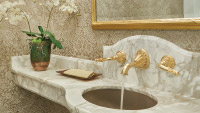Burns Residence
Like many of Seattle’s grand homes, the Burns residence retained its original formal grace while undergoing a variety of additions and remodels that slowly eroded its traditional details and finishes. Working closely with the owners, we returned the kitchen, bathrooms, and powder room to their former elegance, drawing upon colors, patterns, and details common when the house was first built. Tile selected for its rich color palate was carefully detailed to work harmoniously with new casework and fixtures as systems throughout the house were invisibly updated.
When George Wellington Stoddard designed the Burns residence in 1929 he had already earned a reputation in Seattle for the design of gracious homes in a variety of revival styles. Educated at the University of Illinois, Stoddard (1896-1967) entered World War I directly after graduation and when discharged moved to Seattle where he worked with his father, Lewis Malcolm Stoddard, under the name Stoddard & Son. Lewis, who was a civil engineer and naval architect, was probably responsible for the constructability of their projects where George, with his training in art and architectural composition, probably took the design lead.
From 1920 until 1929 when Lewis retired, Stoddard & Son designed fashionable homes in many of Seattle’s best neighborhoods – Queen Anne, Capitol Hill, Laurelhurst, Windermere, Washington Park, and Broadmoor – a practice continued after George opened his firm Stoddard & Associates. But Stoddard’s many design talents were not spent only on homes; during his long career he also designed a wide range of building types including apartments, industrial plants, restaurants, stores, and hotels. As architectural fashion evolved in the 1930s Stoddard designed several remarkable Art Deco buildings like the Metropolitan Printing Press. In the late 1940s and early 1950s he embraced modernism, designing a number of schools, medical buildings, banks, stores and apartments that were frequently innovative and experimental in design and construction. After a long career, George Wellington Stoddard retired in 1960.
The Burns family no doubt watched from their comfortable Tudor home as Stoddard’s career blossomed, Seattle grew, and architectural fashion changed. When they moved into the new home in early 1930 Frank was already well established as one of Seattle’s top insurance agents, having moved west from Chicago with his wife Katherine and young daughter Barbara around 1923. Barbara and her brother James grew up in the house and attended the University of Washington, living there until early adulthood; Barbara leaving in 1941 to marry and James in 1943 to join the U.S. Army. In 1945 Frank Burns passed away at the age of 65, after which Katherine remarried and sold the house.








